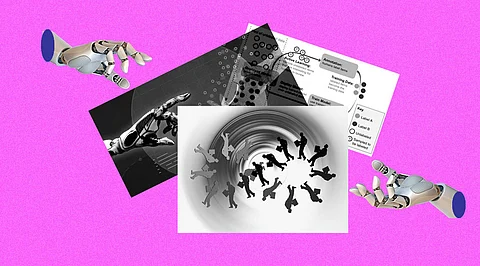

AI models are trained on reams of data collected over the years. But the AI's role is not to solve a general problem but specific ones. The odds of not finding the required amounts of data sets that suit your specific problem are very high. There is every chance that the team can go on a data-gathering marathon only to end up at a dead-end called a data trap. The AI models' understanding is based on sheer numbers and cold calculations for them to make presumably accurate predictions. But in reality, they lack the kind of certainty in understanding the context, which humans exhibit. To make up for this gap, human involvement is considered an unavoidable element in executing an ML cycle. This is where HITL or the Humans in the loop mechanism comes in. A human-in-the-loop model allows humans to validate a machine learning model as the right or wrong one at the time of training.
A machine learning project precisely begins with data preparation and unfortunately, it is one task that eats up most of a project's valuable time. Data preparation is absolutely necessary because not spending enough time understanding and labeling the data is a sure formula for a project's failure. In the HITL model, the labeling task is assigned to a well-minded human being who can differentiate and categorize to make the job of a machine learning algorithm easy in picking the right set of data. The question of how much a human should be involved comes down to the Pareto principle, which ML developers sincerely adopt – 80% computer-driven AI, 19% human input, and 1% randomness. In 2020, Google Health's medical AI system, DeepMind, detected more than 2,600 breast cancer cases than a radiologist could have. In medical cases, there is every possibility of exceptions. The point of argument here is that employing the HITL model would bring more accuracy to the diagnostic tests, wherein few cases might turn out to be non-cancerous cysts. Definitely, we would prefer to have 99% accuracy to 80% accuracy.
To answer this question, we need to understand what happens throughout the cycle. First humans label the data, which constitutes a part of data preparation, for the models are fed only high-quality data. Given the diversity and complexity of practical situations, an ML model should be tuned to all the probable situations which include, overfitting, teaching classifiers about edge cases, or new categories of data in the model's purview. In quite many cases, it happens that despite all the training and tuning, the model turns unconfident about a judgment or overly confident about an incorrect decision. In the HITL model, a human can just swoop-in with his feedback. Thus, HITL achieves what a human being or a machine couldn't achieve alone, and with continuous feedback, the machine learns to perform better. Also, HITL provides a larger playground for testing ML models, which is one of the most important MLOps practices.
When the data is too small in size, the probability of overfitting the data values are high. This means the model makes generalizations over a small set of data and when presented with rare values, the conclusions drawn are the direct result of the pattern it learns from the not-so-relatable data. This problem can be addressed either by adding more data, increasing the data set size through data transformation techniques, regularising the data, removing features from data, or increasing the model complexity. Even in the case of underfitting, when the model fails to recognize the underlying pattern just because it has some outliers distorting the picture, similar techniques work. All these techniques come with few drawbacks – undesired and result in suboptimal predictions. HITL can help in two ways. Either the ML engineer can pause the model to readjust the model for it to restart with enhanced architecture or attempt on-the-fly label correction to mitigate classification errors. ML models are destined to drift with changing databases and hence the need for adjustment, as past performance can never guarantee future results. In all such cases, HITL is the rudder.
Join our WhatsApp Channel to get the latest news, exclusives and videos on WhatsApp
_____________
Disclaimer: Analytics Insight does not provide financial advice or guidance on cryptocurrencies and stocks. Also note that the cryptocurrencies mentioned/listed on the website could potentially be scams, i.e. designed to induce you to invest financial resources that may be lost forever and not be recoverable once investments are made. This article is provided for informational purposes and does not constitute investment advice. You are responsible for conducting your own research (DYOR) before making any investments. Read more about the financial risks involved here.
